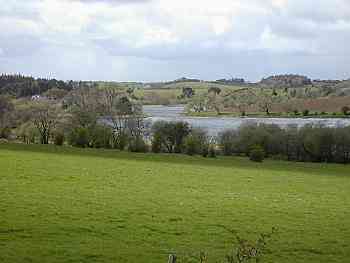Location and Access
![]() A large inland loch (2km in length) found two kilometres south of Coylton. Take the B742 from Coylton and turn off left at NS 402 183 for the south side or continue along the B742 and take first left after the Jelliston turning and the manor house is beside the loch. This latter access point is private, though currently the owner does allow access if he is notified and all common courtesies are followed. There is access to the loch from the south with parking at two spots, firstly, at the road junction at NS 405 177, and secondly at the small lay-by at NS 403 173. From these two parking spots the southern side of the loch can be explored and viewed. A telescope is recommended.
A large inland loch (2km in length) found two kilometres south of Coylton. Take the B742 from Coylton and turn off left at NS 402 183 for the south side or continue along the B742 and take first left after the Jelliston turning and the manor house is beside the loch. This latter access point is private, though currently the owner does allow access if he is notified and all common courtesies are followed. There is access to the loch from the south with parking at two spots, firstly, at the road junction at NS 405 177, and secondly at the small lay-by at NS 403 173. From these two parking spots the southern side of the loch can be explored and viewed. A telescope is recommended.

![]() These are narrow country roads with no surfaced laybys or safe refuges for wheelchair users to avoid passing traffic. Limited opportunities to view from car.
These are narrow country roads with no surfaced laybys or safe refuges for wheelchair users to avoid passing traffic. Limited opportunities to view from car.
![]() On good network of byways linking through to Ayr and Cumnock, but beware of opencast mining traffic near Cumnock.
On good network of byways linking through to Ayr and Cumnock, but beware of opencast mining traffic near Cumnock.
Birds
Martnaham Loch holds SSSI status for the western half of its spread. The south-western end of the loch is bordered by mixed woodland which can be productive in the summer. Access is limited, so pay attention to sign-posting. It is a significant freshwater site for its size and orientation. Whilst its shape runs predominately south-west to north-east, there are enough inlets and bays to provide shelter from the wind coming from any direction. Maybe it is because of this that Martnaham boasts some notable rarities over the years, including more recently a returning long-staying male Smew, a Ring-necked Duck, Black Tern, Lesser Scaup and Hobby.
Autumn and winter see reasonable flocks of ducks, including Goldeneye, Wigeon, Pochard and Teal. There is also the chance of seeing Shoveler, Scaup, Long-tailed Duck and Gadwall. During stormy weather large flocks of gulls have been known to congregate, with rarer visitors such as Glaucous, Iceland and Mediterranean Gulls. Late winter can see reasonable flocks of Greylag Geese and Whooper Swans gathering in the nearby fields. An early start is recommended to see the geese before they leave the loch to feed in the surrounding area.
With lower water levels in autumn, passage waders can often be found at the eastern end. During migration keep an eye out for the raptors that follow the migrating birds. Great Crested and Little Grebe breed, while the latest birds to start breeding include Canada Geese in 2000.
The loch is also good for passage birds: Oystercatcher, Curlew, Redshank, Common Sandpiper, Whimbrel, Ruff, Green Sandpiper, Black-tailed Godwit, Wheatear and Whinchat. Large numbers of hirundines also use the loch to feed and roost at this time.
The article That Redhead’s No Lady by Dave Grant describes the moulting of a Martnaham Smew. This originally appeared in Ayrshire Bird Report 2001.
Other Information
Whilst in the locality, the smaller Fergus Loch (NS 9 18) and Snipe Loch (NS 8 17) should also be checked for interest. The fields surrounding the former loch have been a favourite haunt of Whooper Swans in past years, with flocks of 0+ birds in late autumn.